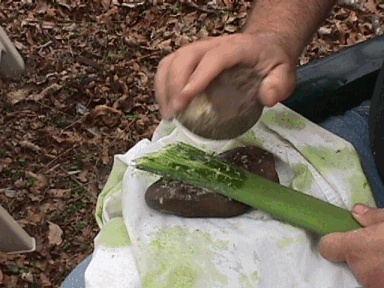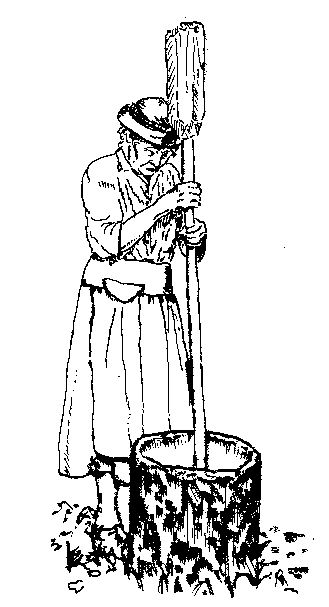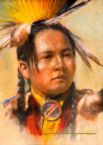What is a tool? A tool is something people use to
help them accomplish their work. A basket is a tool for a woman gathering plants. A handy rock can be a hammer.  A bow and arrows are tools used by a hunter or a warrior. Someone making a bow would use a stone scraper to shave
and shape the wood. A woman preparing an animal skin might use the same scraper to remove the fat and flesh from the
inside part of the skin and a sharp flake of flint to cut it with. A pottery maker used polished pebbles to shape and
smooth their pots. A woman making clothing would use a stone knife to cut leather with, an bone awl to make holes in
the leather and a bone needle to pull sinew thread thru the holes made by the awl. The Indians had as many kinds of
tools as they had jobs to do that needed tools.
A bow and arrows are tools used by a hunter or a warrior. Someone making a bow would use a stone scraper to shave
and shape the wood. A woman preparing an animal skin might use the same scraper to remove the fat and flesh from the
inside part of the skin and a sharp flake of flint to cut it with. A pottery maker used polished pebbles to shape and
smooth their pots. A woman making clothing would use a stone knife to cut leather with, an bone awl to make holes in
the leather and a bone needle to pull sinew thread thru the holes made by the awl. The Indians had as many kinds of
tools as they had jobs to do that needed tools.
When we think of Indian tools it is stone tools that first
come to mind. There is a simple reason for this. It is the stone tools that have survived buried in the dirt.
The wood, bone, leather and fiber tools disappeared, dissolved back into the soil over the years. In collections it
is also the stone parts of tools that survived the years. In old private collections the leather, wood and fibers often
dried out and cracked till the tool was falling apart and unattractive. So people kept the stone parts and threw the
rest away over the years.
Indians made many kinds of tools out of many kinds of
materials. They made digging sticks that were simply a long strong stick with a point. They had hoes made
from animal bones and from shells attached to wood handles. Axes were made often made from ground and polished stone
instead of the chipped stone we usually think of. Hooks for fishing were often made from slivers of shells.
Many tools were made up of several materials combined.
A arrow had a stone or bone point, a wood or cane shaft and feathers, all held together with some kind of cord and often with
some kind of glue.
Indian tools were usually made from the materials that
were available where the Indians lived. Indians who lived in woods where trees and wood was available made more tools
from wood. Indians who lived in the desert made more stone tools and made do without wooden handles. Where workable
stone was scarce Indians used bone instead. A good example is the Eskimos who lived where there was neither stone or
wood. They used animal bones to make almost all their tools.
Often it took one tool or set of tools to make other tools.
So we find a wide variety of Indian tools once we think about what tools Indians would need.
Each culture and each kind of work within a culture
uses its own unique tool kit. This is how archeologist can tell long lost cultures apart. Different Indian cultures
at different times each made its own kind of dart points. Archeologists can also use tool kits to tell about the activities
in an archeological site. A hunting camp will have tools to butcher animals and process the animal's parts. A
farming village will have pottery and hoes.

Other Kinds of Tools
This Indian woman is using a corn mill. A corn mill
is used to grind, or crush in this case, corn into a flour. This mill is really a mortar and pestle. The pestle
is the stick with the big ends she is holding. The mortar is a hollow tree stump. She is using the pestle to pound
on dry corn kernels inside the mortar. These are wooden tools used to process food. To read a funny Indian story
about a corn mill go to the Caddo Indian page.
The first picture above is a great mortar and pestle example.
The mortar is a hole in a piece of limestone rock. The pestle is the rock the man holds. This one
was used to milk a plant for medicine. I think the pestle here is way too small, but you get the idea. I would
guess the real pestle was a stick the size of a baseball bat. It was used like the one the woman in the other picture is using.
But, the Indians did use stone pestles too.

